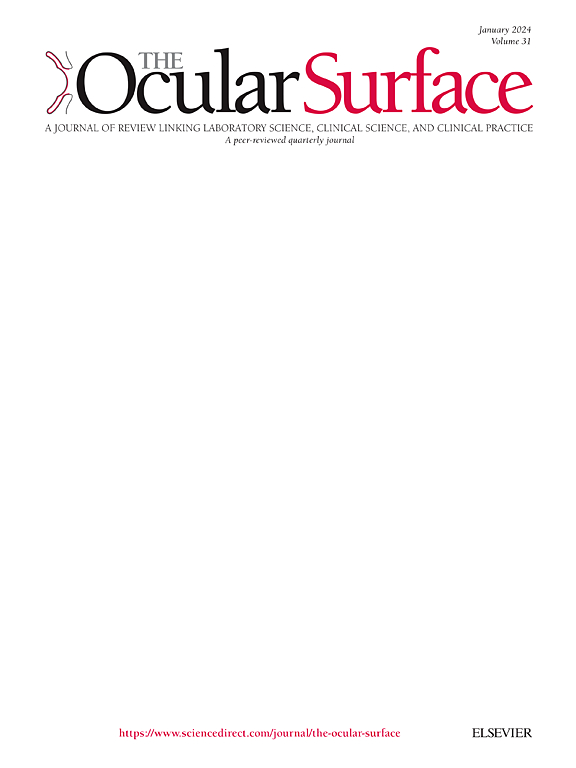利用跨物种泪液蛋白的比较分析鉴定可翻译的干眼病动物模型
IF 5.6
1区 医学
Q1 OPHTHALMOLOGY
引用次数: 0
摘要
目的本研究旨在评估实验动物和人类泪液蛋白的相似性,以确定干眼病(DED)最具可转译性的动物模型。方法选取6种正常人泪液中与DED相关的蛋白进行结构和理化比较。利用BLAST对氨基酸序列进行比较。用ExPASy测定蛋白一级结构、等电点(pI)和亲水性大平均值(GRAVY),并与人作比较。结果在非灵长类动物中,猫(69.7%)和猪(68.7%)与人类的蛋白质序列相似性最高。反刍动物和猫的氨基酸含量变化最大,蛋白质含量≥3/15。猪、兔、狗和啮齿动物的pI值与人类最接近,而猫的pI值最高(9/15),与人类的pI值相差甚远。猪和狗的肉汁值最接近人类。泪溶因子研究表明,猪是唯一一种在所有蛋白质上具有高度相似性的物种(60%)。除了小鼠的IL-6、啮齿动物和猪的IL-8外,大多数物种的氨基酸含量与人类相似。不同物种的pI和GRAVY值各不相同,尽管猪和羊是仅有的在5个因素中有4个与人类相似的pI。结论在非灵长类哺乳动物中,猪与人在泪液蛋白分析上的相似性最高,表明猪模型可能是最适合用于DED研究的模型。本文章由计算机程序翻译,如有差异,请以英文原文为准。
Identification of a translatable animal model for dry eye disease using comparative analysis of tear proteins across species
Purpose
This study aimed to assess the similarity of tear proteins between experimental animals and humans to identify the most translational animal model for dry eye disease (DED).
Methods
Eleven species were selected for a structural and physicochemical comparison of healthy human tear fluid proteins involved in DED. Amino acid sequences were compared using BLAST. Protein primary structure, isoelectric point (pI) and grand average of hydropathicity (GRAVY) were determined using ExPASy and compared with humans.
Results
Among non-primate mammals, the cat (69.7 %) and pig (68.7 %) showed the highest protein sequence similarity to humans. The ruminants and cat showed amino acid content changes for the highest number of proteins (≥3/15). The pig, rabbit, dog and rodents had the closest global pI values to humans, while the cat showed the highest protein number (9/15) with pI values far from humans. GRAVY values for the pig and dog were the closest to humans. Tear-soluble factor study revealed that the pig was the only species with high similarity for all proteins (>60 %). Amino acid content was similar for most species compared to humans, except mouse for IL-6 and rodents and pig for IL-8. The pI and GRAVY values varied across species, though the pig and sheep were the only ones with similar pI to humans for four out of five factors.
Conclusion
The pig exhibited the highest similarity to humans in tear protein analysis among non-primate mammals, suggesting that the porcine model may be the most translational for DED research.
求助全文
通过发布文献求助,成功后即可免费获取论文全文。
去求助
来源期刊

Ocular Surface
医学-眼科学
CiteScore
11.60
自引率
14.10%
发文量
97
审稿时长
39 days
期刊介绍:
The Ocular Surface, a quarterly, a peer-reviewed journal, is an authoritative resource that integrates and interprets major findings in diverse fields related to the ocular surface, including ophthalmology, optometry, genetics, molecular biology, pharmacology, immunology, infectious disease, and epidemiology. Its critical review articles cover the most current knowledge on medical and surgical management of ocular surface pathology, new understandings of ocular surface physiology, the meaning of recent discoveries on how the ocular surface responds to injury and disease, and updates on drug and device development. The journal also publishes select original research reports and articles describing cutting-edge techniques and technology in the field.
Benefits to authors
We also provide many author benefits, such as free PDFs, a liberal copyright policy, special discounts on Elsevier publications and much more. Please click here for more information on our author services.
Please see our Guide for Authors for information on article submission. If you require any further information or help, please visit our Support Center
 求助内容:
求助内容: 应助结果提醒方式:
应助结果提醒方式:


